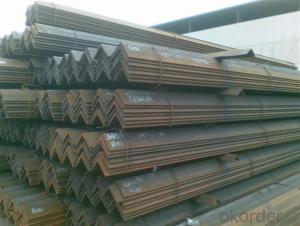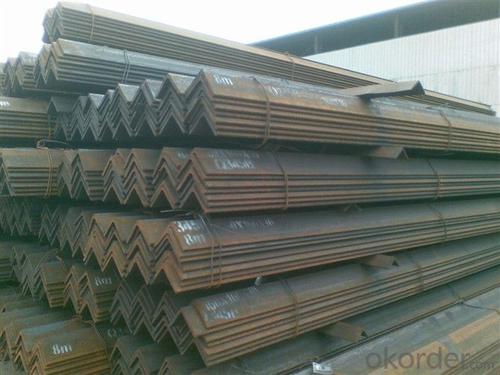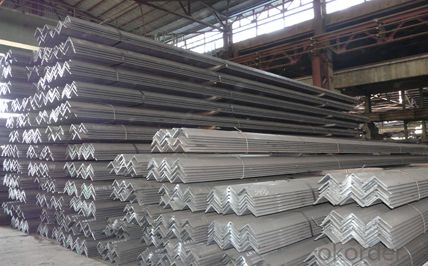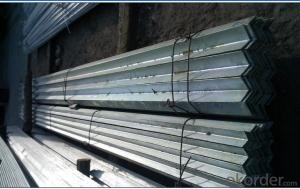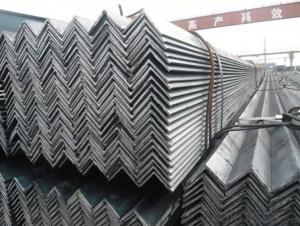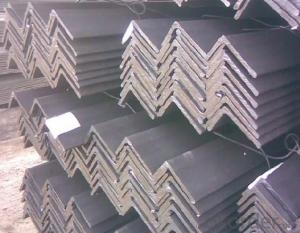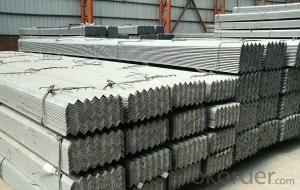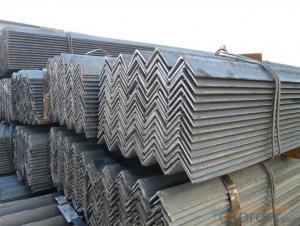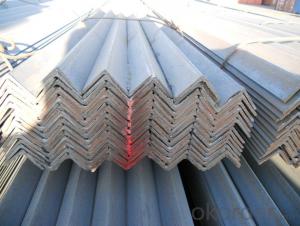Q345 Material High Quality Angle Steel
- Loading Port:
- Tianjin
- Payment Terms:
- TT or LC
- Min Order Qty:
- 25 m.t.
- Supply Capability:
- 2000 m.t./month
OKorder Service Pledge
OKorder Financial Service
You Might Also Like
Product Description:
OKorder is offering Angle Steel great prices with worldwide shipping. Our supplier is a world-class manufacturer of steel, with our products utilized the world over. OKorder annually supplies products to European, North American and Asian markets. We provide quotations within 24 hours of receiving an inquiry and guarantee competitive prices.
Product Applications:
According to the needs of different structures, Angle can compose to different force support component, and also can be the connections between components. It is widely used in various building structures and engineering structures such as roof beams, bridges, transmission towers, hoisting machinery and transport machinery, ships, industrial furnaces, reaction tower, container frame and warehouse etc.
Product Advantages:
OKorder's Angle Steelare durable, strong, and resist corrosion.
Main Product Features:
· Premium quality
· Prompt delivery & seaworthy packing (30 days after receiving deposit)
· Corrosion resistance
· Can be recycled and reused
· Mill test certification
· Professional Service
· Competitive pricing
Product Specifications:
1. Invoicing on theoretical weight or actual weight as customer request
2. Length: 6m, 9m, 12m as following table
3. Sizes
Sizes: 25mm-250mm | ||
a*t | ||
25*2.5-4.0 | 70*6.0-9.0 | 130*9.0-15 |
30*2.5-6.6 | 75*6.0-9.0 | 140*10-14 |
36*3.0-5.0 | 80*5.0-10 | 150*10-20 |
38*2.3-6.0 | 90*7.0-10 | 160*10-16 |
40*3.0-5.0 | 100*6.0-12 | 175*12-15 |
45*4.0-6.0 | 110*8.0-10 | 180*12-18 |
50*4.0-6.0 | 120*6.0-15 | 200*14-25 |
60*4.0-8.0 | 125*8.0-14 | 250*25 |
Note:
1. According to national standard (GB) for our products, if not, supply according to national standards (GB) or agreement.
2. We can not only provide electric furnace +LF+VD and electro-slag re-melting (ESR)steel forging materials, but also forging products of piece, bar, etc.
3. Our company is equipped with roll equipment and can provide our customers with roll billets or finished.
4. Please send us your detailed specifications when inquire. We will reply to you ASAP.
FAQ:
Q1: Why buy Materials & Equipment from OKorder.com?
A1: All products offered byOKorder.com are carefully selected from China's most reliable manufacturing enterprises. Through its ISO certifications, OKorder.com adheres to the highest standards and a commitment to supply chain safety and customer satisfaction.
Q2 What makes stainless steel stainless?
A2 Stainless steel must contain at least 10.5 % chromium. It is this element that reacts with the oxygen in the air to form a complex chrome-oxide surface layer that is invisible but strong enough to prevent further oxygen from "staining" (rusting) the surface. Higher levels of chromium and the addition of other alloying elements such as nickel and molybdenum enhance this surface layer and improve the corrosion resistance of the stainless material.
Q3 Can stainless steel rust?
A3 Stainless does not "rust" as you think of regular steel rusting with a red oxide on the surface that flakes off. If you see red rust it is probably due to some iron particles that have contaminated the surface of the stainless steel and it is these iron particles that are rusting. Look at the source of the rusting and see if you can remove it from the surface.
Images:
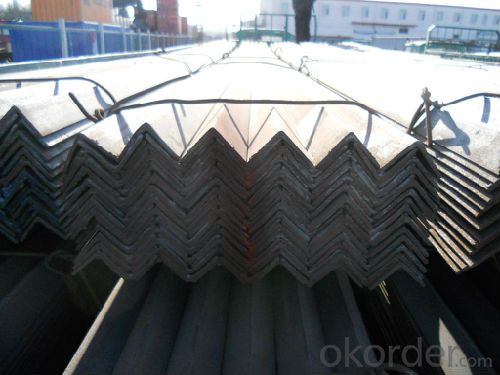
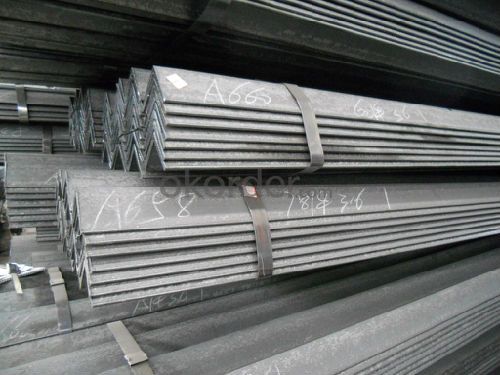
- Q: Can steel angles be used for wall bracing?
- Indeed, wall bracing can make use of steel angles. These angles are frequently employed in construction to offer structural support and reinforcement. Their primary function is to fortify walls and ensure the overall stability of the edifice. Owing to their robustness and longevity, steel angles are a highly suitable option for wall bracing purposes. Furthermore, their fabrication and installation are straightforward, rendering them a cost-efficient solution for wall bracing requirements.
- Q: Are steel angles available in different grades?
- Yes, steel angles are available in different grades. Steel angles are commonly made from carbon steel, which is available in various grades such as A36, A572, and A588. These grades have different chemical compositions and mechanical properties, making them suitable for different applications. Additionally, stainless steel angles are also available in different grades such as 304 and 316, which offer excellent corrosion resistance properties. The choice of steel angle grade depends on the specific requirements of the project, including strength, durability, and corrosion resistance.
- Q: How do you prevent steel angles from vibrating under dynamic loads?
- One possible way to prevent steel angles from vibrating under dynamic loads is by using damping techniques. Damping involves adding materials or structures that absorb or dissipate the energy generated by the vibrating steel angles. This can be achieved by attaching damping pads or strips made of viscoelastic materials to the steel angles, which help absorb and dissipate the vibration energy. Another approach is to incorporate dampers such as tuned mass dampers or friction dampers, which are designed to reduce vibrations by adding additional mass or introducing friction forces to counteract the dynamic loads. Proper design and reinforcement of the steel angles can also help to increase their stiffness and reduce the likelihood of vibration.
- Q: How do steel angles contribute to the resiliency of a structure?
- Steel angles contribute to a structure's resiliency in multiple ways. Firstly, they distribute the load across different members, providing added structural support and stability. In construction projects, steel angles are often used as reinforcements or braces, enabling the transmission of forces and preventing excessive deflection or deformation. This helps the structure resist external forces like wind, earthquakes, or heavy loads, ultimately enhancing its overall resilience. Furthermore, steel angles possess high durability and corrosion resistance, further bolstering a structure's resiliency. Steel, as a material, boasts exceptional strength and longevity, making it particularly well-suited for enduring harsh environmental conditions and potential structural failures. This durability ensures the structure can withstand the test of time, reducing the need for frequent repairs or replacements and ultimately improving its overall resilience. Additionally, steel angles offer flexibility in design and construction, facilitating efficient load transfer and optimized structural configurations. They can be easily customized and fabricated to meet specific project requirements, guaranteeing the structure can be tailored to withstand various dynamic and static loads. This adaptability enhances the structure's resiliency by enabling it to adapt to changing conditions or future modifications. In summary, steel angles play a vital role in enhancing a structure's resiliency by providing additional support, durability, and flexibility. Their ability to distribute loads, resist external forces, and withstand harsh conditions ensures the structure can withstand unexpected events and maintain its integrity. As such, steel angles are an indispensable component of resilient construction practices.
- Q: Are steel angles available in different grades of steel?
- Yes, steel angles are available in different grades of steel. Steel angles are commonly used in construction and manufacturing industries for various applications such as structural support, framing, and bracing. The grade of steel used in steel angles is determined by its chemical composition, mechanical properties, and intended use. Some common grades of steel used for steel angles include A36, A572, and A588. Each grade of steel has specific characteristics that make it suitable for different purposes. For example, A36 steel angles are commonly used for general structural applications, while A572 steel angles have higher strength and are often used in heavy-duty construction projects. The choice of grade depends on factors such as load-bearing capacity, corrosion resistance, and cost considerations.
- Q: Can steel angles be used for support brackets?
- Yes, steel angles can be used for support brackets. Steel angles are commonly used in construction and engineering applications due to their strength and versatility. They have a triangular shape with equal sides and can be easily fastened to walls, beams, or other structures to provide support. Steel angles are frequently used as support brackets for shelving, countertops, and other heavy items. They are capable of bearing significant loads and provide stability and durability to the supported structure.
- Q: Can steel angles be used in the construction of solar panel support structures?
- Indeed, the utilization of steel angles is viable for the establishment of support structures for solar panels. The construction sector frequently utilizes steel angles owing to their robustness and endurance. They offer exceptional support and stability, which are vital aspects for solar panel installations. The fusion or fastening of steel angles can be effortlessly accomplished to form sturdy and inflexible structures capable of enduring the weight of solar panels and the diverse environmental conditions, including wind and snow loads, to which they may be exposed. Furthermore, steel angles can be tailored to meet the precise design prerequisites of the support structure for solar panels, rendering them a versatile option for construction ventures.
- Q: How do you calculate the torsional strength of a steel angle?
- The torsional strength of a steel angle can be calculated by determining the moment of inertia of the angle cross-section and then applying the torsion formula, which relates the applied torque to the torsional stress and the polar moment of inertia.
- Q: Can steel angles be used for platform structures?
- Yes, steel angles can be used for platform structures. Steel angles are commonly used in construction for their strength, durability, and versatility. They provide structural support and stability to various types of platforms, including elevated walkways, mezzanines, catwalks, and scaffolding. Steel angles offer excellent load-bearing capacity and can withstand heavy loads, making them suitable for platform structures that require a high level of strength and stability. Additionally, steel angles can be easily fabricated and joined together, allowing for efficient construction and customization of platform structures.
- Q: How do you calculate the moment resistance of a steel angle connection?
- To calculate the moment resistance of a steel angle connection, several factors need to be considered. Firstly, determine the yield strength of the steel angle. This can be found in the material specification or by conducting a tensile test on a sample of the steel angle. Next, calculate the effective length of the steel angle. This is the distance between the point of application of the moment and the point where the angle connects to the supporting structure. Then, determine the cross-sectional properties of the steel angle, including its moment of inertia and section modulus. These can be calculated using standard formulas or obtained from manufacturer's data. With these values, the moment resistance can be calculated using the formula M = fy * Z, where M is the moment resistance, fy is the yield strength of the steel angle, and Z is the plastic section modulus of the angle. It is important to note that the moment resistance calculation assumes that the steel angle behaves elastically up to its yield strength. If the angle is subjected to moment beyond its yield strength, plastic deformation will occur, and the actual moment resistance may differ. In such cases, additional factors like strain hardening and post-yield behavior need to be considered for an accurate calculation.
Send your message to us
Q345 Material High Quality Angle Steel
- Loading Port:
- Tianjin
- Payment Terms:
- TT or LC
- Min Order Qty:
- 25 m.t.
- Supply Capability:
- 2000 m.t./month
OKorder Service Pledge
OKorder Financial Service
Similar products
Hot products
Hot Searches
Related keywords
